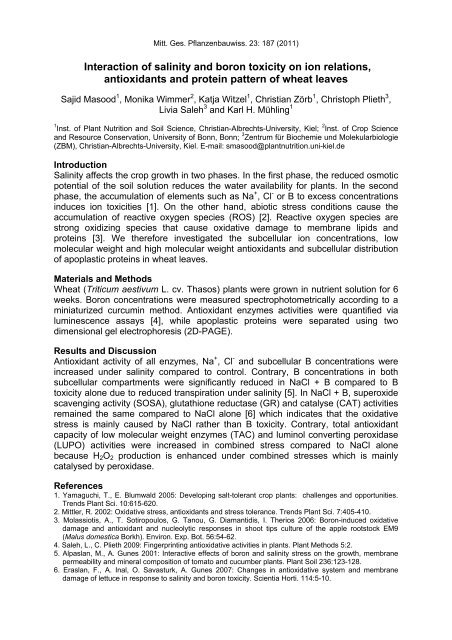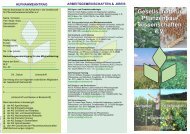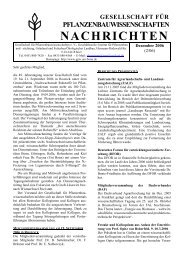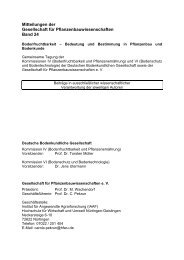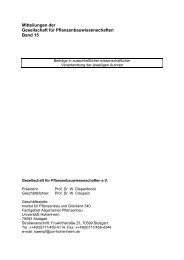Mitteilungen der Gesellschaft für Pflanzenbauwissenschaften Band 23
Mitteilungen der Gesellschaft für Pflanzenbauwissenschaften Band 23
Mitteilungen der Gesellschaft für Pflanzenbauwissenschaften Band 23
Sie wollen auch ein ePaper? Erhöhen Sie die Reichweite Ihrer Titel.
YUMPU macht aus Druck-PDFs automatisch weboptimierte ePaper, die Google liebt.
Mitt. Ges. Pflanzenbauwiss. <strong>23</strong>: 187 (2011)<br />
Interaction of salinity and boron toxicity on ion relations,<br />
antioxidants and protein pattern of wheat leaves<br />
Sajid Masood 1 , Monika Wimmer 2 , Katja Witzel 1 , Christian Zörb 1 , Christoph Plieth 3 ,<br />
Livia Saleh 3 and Karl H. Mühling 1<br />
1 Inst. of Plant Nutrition and Soil Science, Christian-Albrechts-University, Kiel; 2 Inst. of Crop Science<br />
and Resource Conservation, University of Bonn, Bonn; 3 Zentrum <strong>für</strong> Biochemie und Molekularbiologie<br />
(ZBM), Christian-Albrechts-University, Kiel. E-mail: smasood@plantnutrition.uni-kiel.de<br />
Introduction<br />
Salinity affects the crop growth in two phases. In the first phase, the reduced osmotic<br />
potential of the soil solution reduces the water availability for plants. In the second<br />
phase, the accumulation of elements such as Na + , Cl - or B to excess concentrations<br />
induces ion toxicities [1]. On the other hand, abiotic stress conditions cause the<br />
accumulation of reactive oxygen species (ROS) [2]. Reactive oxygen species are<br />
strong oxidizing species that cause oxidative damage to membrane lipids and<br />
proteins [3]. We therefore investigated the subcellular ion concentrations, low<br />
molecular weight and high molecular weight antioxidants and subcellular distribution<br />
of apoplastic proteins in wheat leaves.<br />
Materials and Methods<br />
Wheat (Triticum aestivum L. cv. Thasos) plants were grown in nutrient solution for 6<br />
weeks. Boron concentrations were measured spectrophotometrically according to a<br />
miniaturized curcumin method. Antioxidant enzymes activities were quantified via<br />
luminescence assays [4], while apoplastic proteins were separated using two<br />
dimensional gel electrophoresis (2D-PAGE).<br />
Results and Discussion<br />
Antioxidant activity of all enzymes, Na + , Cl - and subcellular B concentrations were<br />
increased un<strong>der</strong> salinity compared to control. Contrary, B concentrations in both<br />
subcellular compartments were significantly reduced in NaCl + B compared to B<br />
toxicity alone due to reduced transpiration un<strong>der</strong> salinity [5]. In NaCl + B, superoxide<br />
scavenging activity (SOSA), glutathione reductase (GR) and catalyse (CAT) activities<br />
remained the same compared to NaCl alone [6] which indicates that the oxidative<br />
stress is mainly caused by NaCl rather than B toxicity. Contrary, total antioxidant<br />
capacity of low molecular weight enzymes (TAC) and luminol converting peroxidase<br />
(LUPO) activities were increased in combined stress compared to NaCl alone<br />
because H2O2 production is enhanced un<strong>der</strong> combined stresses which is mainly<br />
catalysed by peroxidase.<br />
References<br />
1. Yamaguchi, T., E. Blumwald 2005: Developing salt-tolerant crop plants: challenges and opportunities.<br />
Trends Plant Sci. 10:615-620.<br />
2. Mittler, R. 2002: Oxidative stress, antioxidants and stress tolerance. Trends Plant Sci. 7:405-410.<br />
3. Molassiotis, A., T. Sotiropoulos, G. Tanou, G. Diamantidis, I. Therios 2006: Boron-induced oxidative<br />
damage and antioxidant and nucleolytic responses in shoot tips culture of the apple rootstock EM9<br />
(Malus domestica Borkh). Environ. Exp. Bot. 56:54-62.<br />
4. Saleh, L., C. Plieth 2009: Fingerprinting antioxidative activities in plants. Plant Methods 5:2.<br />
5. Alpaslan, M., A. Gunes 2001: Interactive effects of boron and salinity stress on the growth, membrane<br />
permeability and mineral composition of tomato and cucumber plants. Plant Soil <strong>23</strong>6:1<strong>23</strong>-128.<br />
6. Eraslan, F., A. Inal, O. Savasturk, A. Gunes 2007: Changes in antioxidative system and membrane<br />
damage of lettuce in response to salinity and boron toxicity. Scientia Horti. 114:5-10.


